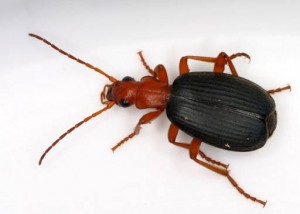I’m working on a book about insects for Chronicle Books right now. I’m in science-geek heaven, up to my eyeballs in research, and wanted to share a tip that I think might help other writers – both students and adults.
When you’re doing research and you come across THE BEST STORY EVER, you need to chase that story all the way back to its source.
Sometimes, you’ll be rewarded with the exact quote you need from a primary source document. And sometimes, you’ll run into a dead end, and you’ll need to let that juicy story go. This can be sad – especially after you’ve put in hours of research – but it’s lot better than perpetuating an often-told but undocumented tall tale in a work of nonfiction.
I experienced both of these research moments with my bug book this week.
BEST STORY EVER #1: Bombardier Beetles
Image via Wikimedia Commons, photo by Patrick Coin
In researching the Bombardier beetle, I found numerous references to a story about the naturalist Charles Darwin’s encounter with one of these beetles. The Bombardier beetle has a great defense mechanism; it shoots a hot, smelly, chemical mist out its rear end when it’s threatened, a fact Darwin supposedly learned the hard way, when he was collecting beetles, ran out of hands, and popped one in his mouth for safe keeping. This, I thought, was the BEST STORY EVER. But in order to use it, I had to find out if it was true.
When you’re reading information on websites, the best ones cite sources, most often within the text or in a list of references the bottom of the page. Source leads to source, and eventually, if you’re lucky, you can follow that bread crumb trail back to the person who told the story to begin with – in this case, Charles Darwin himself. I found out that this particular BEST STORY EVER actually came from Darwin’s published autobiography. Here’s the quote:
“I will give proof of my zeal: one day, on tearing off some old bark, I saw two rare beetles, and seized one in each hand; then I saw a third and new kind, which I could not bear to lose, so that I popped the one which I held in my right hand into my mouth. Alas! It ejected some intensely acrid fluid, which burnt my tongue so that I was forced to spit the beetle out, which was lost, as was the third one.”
My favorite thing about this quote is the matter-of-fact way in which Darwin describes popping the beetle into his mouth for storage as if it’s a regular thing. Because that’s what we all do, you know, when we’ve run out of hands for collecting beetles.
Verdict: This BEST STORY EVER can be verified, at least to the degree that Charles Darwin himself tells the story. A side note: I still have no idea if Darwin was telling the truth, since he was alone with the beetles, but I can phrase my storytelling in a way that reflects this. This BEST STORY EVER makes the cut.
(If you want to read more about Bombardier beetles, Sarah Albee, author of BUGGED: HOW INSECTS CHANGED THE WORLD, has a great blog post called “Please Don’t Eat the Beetles” here.)
BEST STORY EVER #2:The Giant Weta
Image courtesy Wikimedia Commons
Another bug I’m featuring in this book is the Little Barrier Island giant weta, which is known as the heaviest insect in the world. It’s also known for its scary appearance; the natives of New Zealand call it wetapunga, which translates to “god of ugly things.” I also read some reports that this insect is pretty indestructible by conventional means. I found half a dozen websites – including some from museums and educational institutions – that reference a story told by Sir Walter Buller, who supposedly tried to kill some wetas for his collection back in 1871 and had little luck. These super-wetas supposedly survived Buller’s attempted drowning and even his brother-in-law’s effort to kill them by plunging them into boiling water.
It’s a great story – but one that I’ve been unable to confirm so far. The closest I’ve come is this 1895 reference in the Transactions and Proceedings of the New Zealand Institute, in which Buller writes about two wetas he found feeding in a tree:
“Dismounting from my horse, I secured the two Wetas in a pocket handkerchief, and hung them up in a tree to await my return a day or two later. On coming back, however, I found that they had eaten their way out and made their escape.”
Side note: Buller apparently didn’t subscribe to the Darwin “pop-it-in-your-mouth” method of insect safe keeping. Or perhaps he did, but giant wetas can be six inches long, so that would have been quite a mouthful.
Anyway, this is a nifty story, but it falls short of providing confirmation for the tale I’d read online. Does that mean the story of the wetas who survived attempted-drowning and being plunged in boiling water isn’t true? No…but it does mean that I haven’t yet found the documentation I need to use it.
Verdict: This BEST STORY EVER doesn’t make the cut unless I manage to turn up a document where Buller tells the story for himself.
One more note on chasing down sources… We teach students (rightfully so) that Wikipedia isn’t a reliable source for research. But it can be a treasure trove of references. The Wikipedia entries that are well done – and many of them are – have a list of references and resources listed at the end of the article, often with links to their original sources in scholarly articles available online.






